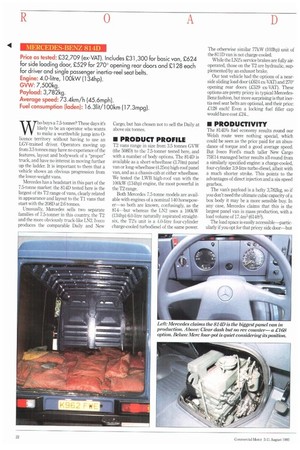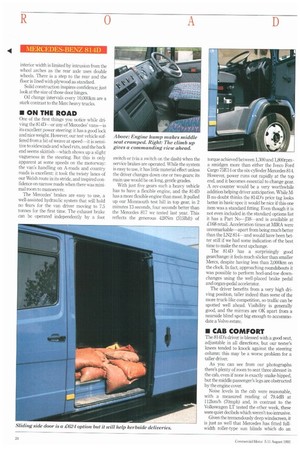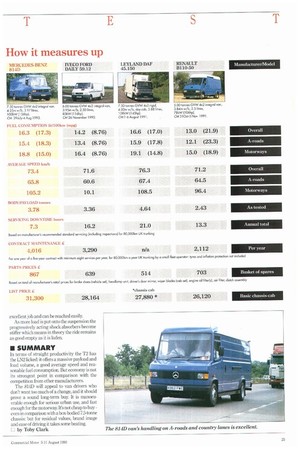W ho buys a 7.5-tonner? These days it's likely to be
Page 24

Page 26

Page 27

If you've noticed an error in this article please click here to report it so we can fix it.
an operator who wants to make a worthwhile jump into 0licence territory without having to use an LGV-trained driver. Operators moving up from 3.5 tonnes may have no experience of the features, layout and bodywork of a "proper" truck, and have no interest in moving further up the ladder. It is important to them that a vehicle shows an obvious progression from the lower-weight vans.
Mercedes has a headstart in this part of the 7.5-tonne market: the 814D tested here is the largest of its T2 range of vans, clearly related in appearance and layout to the Ti vans that start with the 208D at 2.6 tonnes Unusually, Mercedes sells two separate families of 7.5-tormer in this country, the T2 and the more obviously truck-like LN2. Iveco produces the comparable Daily and New Cargo, but has chosen not to sell the Daily at above six tonnes.
• PRODUCT PROFILE
1'2 vans range in size from 3.5 tonnes GVW (the 508D) to the 7.5-tonner tested here, and with a number of body options. The 814D is available as a short-wheelbase (3.70m) panel van or long-wheelbase (4.25m) high-roof panel van, and as a chassis-cab at either wheelbase. We tested the LWB high-roof van with the 100kW (134hp) engine, the most powerful in the T2 range.
Both Mercedes 7.5-tonne models are available with engines of a nominal 140 horsepower—so both are known, confusingly, as the 814—but whereas the LN2 uses a 100kW (134hp) 6.0-litre naturally aspirated straight. six, the T2's unit is a 4.0-litre four-cylinder charge-cooled turbodiesel of the same power. The otherwise similar 77kW (103hp) unit of the 811D van is not charge-cooled.
While the LN2's service brakes are fully airoperated, those on the T2 are hydraulic, supplemented by an exhaust brake.
Our test vehicle had the options of a nearside sliding load door (£624 ex-VAT) and 2700 opening rear doors (£529 ex-VAT). These options are pretty pricey in typical MercedesBenz fashion, but more surprising is that inertia-reel seat belts are optional, and their price: £128 each! Even a locking fuel filler cap would have cost £24...
• PRODUCTIVITY
The 8141.Ys fuel economy results round our Welsh route were nothing special, which could be seen as the price paid for an abundance of torque and a good average speed. But Iveco Ford's much taller New Cargo 75E14 managed better results all-round from a similarly specified engine: a charge-cooled, four-cylinder 3.9-litre turbo-diesel, albeit with a much shorter stroke. This points to the advantages of direct injection and a six-speed gearbox.
The van's payload is a hefty 3,782kg, so if you don't need the ultimate cubic capacity of a box body it may be a more sensible buy. In any case, Mercedes claims that this is the largest panel van in mass production, with a load volume of 17.4m3 (614ft3).
The load space is easily accessible—particularly if you opt for that pricey side door—but interior width is limited by intrusion from the wheel arches as the rear axle uses double wheels. There is a step to the rear and the floor is lined with plywood as standard.
Solid construction inspires confidence; just look at the size of those door hinges.
Oil change intervals every 10,000km are a stark contrast to the Mem heavy trucks.
• ON THE ROAD
One of the first things you notice while dri ving the 814D or any of Mercedes' vans—is its excellent power steering: it has a good lock and nice weight. However, our test vehicle suffered from a bit of weave at speed—it is sensitive to sidewinds and wheel ruts, and the back end seems skittish which shows up a slight vagueness in the steering. But this is only apparent at some speeds on the motorway: the van's handling on A-roads and country roads is excellent: it took the twisty lanes of our Welsh route in its stride, and inspired confidence on narrow roads when there was minimal room to manoeuvre.
The Mercedes' brakes are easy to use, a well-assisted hydraulic system that will hold no fears for the van driver moving to 7.5 tonnes for the first time. The exhaust brake can be operated independently by a foot switch or (via a switch on the dash) when the service brakes are operated. While the system is easy to use, it has little material effect unless the driver changes down one or two gears: its main use would be on long, gentle grades.
With just five gears such a heavy vehicle has to have a flexible engine, and the 8141) has a more flexible engine than most. It pulled up our Monmouth test hill in top gear, in 2 minutes 13 seconds, four seconds better than the Mercedes 817 we tested last year. This reflects the generous 428Nm (3151bft) of torque achieved between 1,300 and 1,800rpm a smidgen more than either the Iveco Ford Cargo 75E14 or the six-cylinder Mercedes 814. However, power runs out rapidly at the top end, and it becomes essential to change gear.
A rev-counter would be a very worthwhile addition helping driver anticipation. While M B no doubt thinks the 814D's price tag looks better in basic spec it would be nice if this one item was a standard fitting. Even though it is not even included in the standard options list it has a Part No—J38—and is available at £168 retail. Acceleration times at MIRA were unremarkable—apart from being much better than the LN2 814—and would have been better still if we had some indication of the best time to make the next upchange.
The 8I4D has a surprisingly good gearchange: it feels much slicker than smaller Mercs, despite having less than 3,000km on the clock. In fact, approaching roundabouts it was possible to perform heel-and-toe downchanges using the well-placed brake pedal and organ-pedal accelerator.
The driver benefits from a very high driving position, taller indeed than some of the more truck-like competition, so traffic can be spotted well ahead. Visibility is generally good, and the mirrors are OK apart from a nearside blind spot big enough to accommodate a Volvo estate.
• CAB COMFORT
The 814D's driver is blessed with a good seat, adjustable in all directions, but our tester's knees tended to knock against the steering column: this may be a worse problem for a taller driver.
As you can see from our photographs there's plenty of room to seat three abreast in the cab, even if none is exactly snake-hipped, but the middle passenger's legs are obstructed by the engine coven Noise levels in the cab were reasonable, with a measured reading of 79.4dB at 112km/h (70mph) and, in contrast to the Volkswagen LT tested the other week, these were quiet decibels which weren't too intrusive.
Given the tremendously deep windscreen, it is just as well that Mercedes has fitted fullwidth roller-type sun blinds which do an excellent job and can be reached easily.
As more load is put onto the suspension the progressively acting shock absorbers become stiffer which means in theory the ride remains as good empty as it is laden.
• SUMMARY
In terms of straight productivity the T2 has the LN2 licked: it offers a massive payload and load volume, a good average speed and reasonable fuel consumption. But economy is not its strongest point in comparison with the competition from other manufacturers.
The 814D will appeal to van drivers who don't want too much of a change, and it should prove a sound long-term buy. It is manoeuvrable enough for serious urban use, and fast enough for the motorway. It's not cheap to buy even in comparison with a box-bodied 7.5-tonne chassis: but for residual values, brand image and ease of driving it takes some beating.
Li by Toby Clark












































































